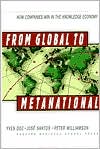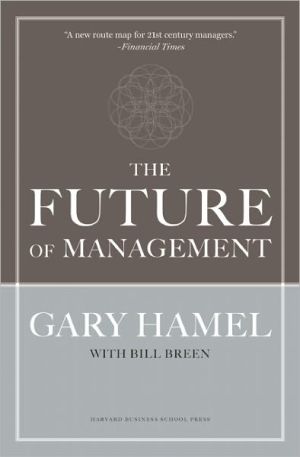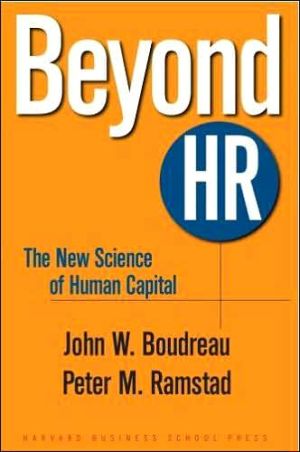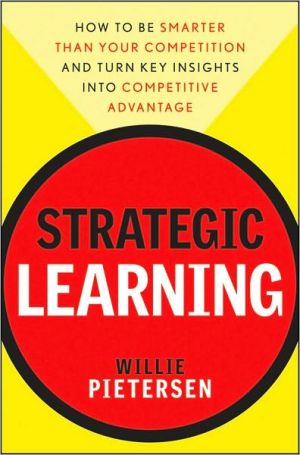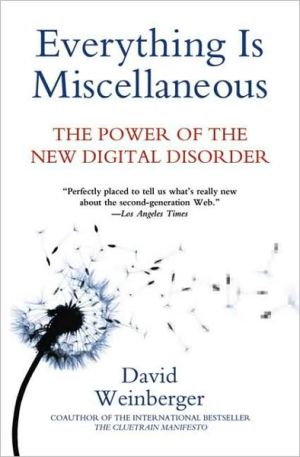From Global to Metanational: How Companies Win in the Knowledge Economy
Becoming a global company once meant penetrating markets around the world. But the demands of the knowledge economy are turning this strategy on its head. Today, the challenge is to innovate by learning from the world . \ This book provides a blueprint for companies ready to embrace this new globalization challenge. In From Global to Metanational , international business and strategy experts Yves Doz, José Santos, and Peter Williamson introduce a radically different kind of company-the...
Search in google:
Becoming a global company once meant penetrating markets around the world. But the demands of the knowledge economy are turning this strategy on its head. Today, the challenge is to innovate by learning from the world . This book provides a blueprint for companies ready to embrace this new globalization challenge. In From Global to Metanational , international business and strategy experts Yves Doz, José Santos, and Peter Williamson introduce a radically different kind of company-the metanational-defined by three core capabilities: being the first to identify and capture new knowledge emerging all over the world; mobilizing this globally scattered knowledge to out-innovate competitors; and turning this innovation into value by producing, marketing, and delivering efficiently on a global scale. The authors explain why traditional global strategies are no longer sufficient to differentiate leading competitors, what the knowledge economy means for managers, and why opportunities to leverage globally dispersed knowledge are growing. Most important, they outline exactly how managers can build a metanational advantage for their own organizations by: Prospecting for and accessing untapped pockets of technology and emerging consumer trends from around the world Leveraging knowledge imprisoned in a multinational's local subsidiaries Mobilizing this fragmented knowledge to generate innovations, profits, and shareholder value Drawing from the experiences of pioneering metanationals including STMicroelectronics, ARM, Acer, Nokia, Shiseido, and PolyGram, the book shows how today's multinationals can use their existing global networks to gain an important head start in the global game-and how newcomers can leapfrog traditional competitors by rapidly building a new-style metanational corporation. Must-reading for every leader-from the CEO of a new global venture, to the executive of a currently successful multinational, to the founder of an e-business startup getting ready to "go global"-this pathbreaking book shows how to reshape strategies to compete and win in the global knowledge economy. New York Times ...this is must reading for anyone who seeks to do international business from the inside, or to observe the workings of multinationals from the outside." "In fact, this is one of the freshest and most important books about managing multinational companies to emerge in recent years.
Chapter One \ \ \ The Metanational Advantage\ \ \ The global game has changed. Yesterday, becoming a global company meant building an efficient network of production, sales, and service subsidiaries capable of penetrating markets around the world. But the demands of the new knowledge economy are turning this strategy on its head. Today the challenge is to innovate by learning from the world. Tomorrow's winners will be companies that create value by searching out and mobilizing untapped pockets of technology and market intelligence that are scattered across the globe.\ Consider the following examples:\ \ \ A money-losing semiconductor firm in Southern Europe became a world leader by combining knowledge drawn from customers in places as diverse as San Jose, California; Tokyo; and Helsinki with pockets of technical expertise scattered from Grenoble to Milan, Noida (in Uttar Pradesh, India), Ang Mo Kio (in Singapore), and Carrolton (in Texas). With this unique combination of specialist knowledge, the firm was able to achieve something that eluded its competitors: It created tailored solutions for customer applications by incorporating dozens of specialized circuits on a single silicon chip. This breakthrough capability provided STMicroelectronics with the foundation for a semiconductor business that has created more than $50 billion in shareholder value and employs more than 40,000 people around the world.\ A record company built an organization capable of identifying future global "hit artists" from local talent in the barsand clubs of cities like Sao Paolo, Reykjavik, Naples, Paris, Athens, and Hong Kong. By connecting this new talent with its own detailed knowledge of the international music markets and its global capabilities in creating, promoting, and distributing new albums, the company was able to sell millions of recordings by these new stars. This capability proved critical to building what was to become the world's largest record company: PolyGram netted its owners a sale price of more than $10 billion in 1998.\ A startup flat-panel display company successfully entered an industry in which competitors have invested hundreds of millions of dollars to establish themselves. It did so by accessing capabilities it found inside institutions and companies including LETI (France), Motorola (USA), Raytheon (USA), Futaba (Japan), Rhône Poulenc (France), SAES Getters (Italy), Unipac (Taiwan), and Sumitomo (Japan) to create a new type of flat-panel display. This unorthodox strategy allowed PixTech to achieve the advantages of global scale overnight.\ \ \ These are just three instances of a powerful new opportunity in the global corporate landscape: the chance to build new types of competitive advantage by connecting globally dispersed knowledge. Our examples are the forerunners of tomorrow's winners in the global game. The success stories of the future will be those firms that excel in sensing specialist knowledge about new technologies and emerging market needs that are scattered anywhere around the globe. They will mobilize this dispersed knowledge to create new products, services, processes, and business models. They will harvest value from those innovations in markets all over the world.\ This new opportunity is being fueled by the emergence of a global knowledge economy, an environment in which:\ \ \ · Competitive advantage is primarily based on knowledge.\ · Not all the knowledge a global company needs to prosper is to be found in one place; instead, it is increasingly scattered around the world.\ · The cost of distance is falling rapidly for commodities that are mobile—capital, goods, and information—so that they are readily accessible by all.\ \ \ The rise of this global knowledge economy means that the opportunities and challenges of exploiting knowledge scattered around the world will become a key concern of senior managers across the spectrum of industries from mining to manufacturing and professional services. The impact won't be confined to a few sectors such as electronics or so-called knowledge-intensive industries. And mobilizing and leveraging globally dispersed knowledge will be just as vital to today's successful American multinationals (such as General Electric or Procter & Gamble) and Japanese giants (such as Matsushita and Toyota) as it is to European companies struggling to overcome Europe's fragmented markets or to Asian and Latin American corporations that have only recently joined the global game.\ Of course, the idea of mobilizing globally dispersed knowledge is not entirely new. In fact, we found that it lay at the heart of some of the most powerful corporate innovations of the past—for instance, the IBM 360, the Airbus A-300, and Hewlett-Packard printers. To date, however, innovation based on accessing, mobilizing, and leveraging pockets of knowledge drawn from around the world has been the exception. In the global knowledge economy, it will be critical to success.\ As companies begin to unlock the value of globally dispersed knowledge, they will no longer be captives of their geographic roots. Nor will they be accused of behaving like twenty-first century imperialists, imposing the exploits of their homeland on malleable markets worldwide. New multinational leaders will emerge from unlikely locations far away from the traditional "capitals" of their industries. Witness the fact that today such a high-tech industry as global mobile communications is being driven by such companies as Nokia and Ericsson, with roots on the edge of the Arctic, and NTT-DoCoMo of Japan; it is not under the sunshine of Silicon Valley.\ The long-term challenge affects today's giants as well as their newly emerging competitors. For established multinationals, success in the future will increasingly depend on their ability to access knowledge from outside their existing subsidiaries and connect it with the skills that are scattered across their global operations network. This capability will allow them to create the innovative products, services, and processes they need in order to win in markets around the world. Building it will require that they dramatically improve their capacity to mobilize knowledge that languishes underexploited within their far-flung network of subsidiaries. But the problem goes far beyond knowing how to leverage knowledge from within an existing network of national subsidiaries. It will not be enough to designate existing countries or global business units as "centers of excellence" or "strategic leaders" for a business unit or product line. Winning in the knowledge economy demands a fundamental shake-up in the way traditional multinational organizations think and act.\ Likewise, the emerging multinationals in the new economy will ultimately depend on their ability to innovate by drawing ideas, technologies, and market knowledge from a global pool. Ironically, revolutionaries such as Yahoo! and Amazon are proving to be conservative when it comes to globalization. In many ways, they are following in the footsteps of the early multinationals of the nineteenth century. Their globalization is achieved by moving sequentially, national market by national market, starting with those most similar to their home base. This strategy allows them to operate with minimal adaptation of their original formula. But the next breed of new economy winners will not blanket the world with a standard offering, projected from home base. Instead, they will succeed by learning from unique pockets of knowledge dotted all over the world and then using this knowledge to fuel a cycle of continuous innovation.\ This book is a manifesto for managers of existing multinationals and budding "globalizers" who are together facing this coming sea change in the way we need to think about the advantages of becoming a world player in the knowledge economy.\ In five years of research, we have seen many examples of companies from every continent—companies such as Acer, Airbus, Citibank, Glaxo Wellcome (now GlaxoSmithKline), Hewlett-Packard, IBM, Nokia, PolyGram (now part of Vivendi Universal), Procter & Gamble, SAP, Shiseido, STMicroelectronics, and Wipro—that are starting to create innovative products, services, and systems by building their capability to access, connect, and leverage knowledge from far-flung, nontraditional sources. The pattern is being repeated by startups like ARM, Logitech, PixTech, and Business Objects. The phenomenon is so striking that we invented a name for it. We call this new competitive capability metanational advantage.\ We chose the prefix meta—from the Greek term for "beyond"—to emphasize a key point: Metanational companies do not draw their competitive advantage from their home country, nor even from a set of national subsidiaries. Metanationals view the world as a global canvas dotted with pockets of technology, market intelligence, and capabilities. They see untapped potential in these pockets of specialist knowledge scattered around the world. By sensing and mobilizing this scattered knowledge, they are able to innovate more effectively than their rivals.\ The metanationals will therefore differ fundamentally from their multinational ancestors. Unlike most of today's multinationals, they won't try to prosper by spreading advantages learned in their American, German, or Japanese headquarters or subsidiaries across the world. Instead, metanationals will focus on prospecting for untapped pockets of knowledge around the world. They will build new types of advantage by connecting and leveraging dispersed pockets of knowledge.\ The metanationals' key advantage won't come from crossing the borders between nation-states; it will come from transcending them. Their vision of economic paradise is not one of global homogeneity, in which it would be easy to deploy homegrown products, technologies, and systems to customers around the world. Quite the opposite is true. The metanationals will thrive on seeking out and exploiting uniqueness. They value geographic and cultural differences. And because they fish for knowledge in a global pond, they can potentially create new and better competencies than any multinational player's headquarters, national subsidiary, or center of excellence.\ \ \ THREE LEVELS OF GLOBAL COMPETITION IN THE NEW KNOWLEDGE ECONOMY\ \ \ The full-fledged metanational corporation does not yet exist. The challenge is to create it ahead of competitors. Some companies already have a head start in the race to build this new type of global advantage. But the challenge of sensing, connecting, and exploiting complex knowledge that is scattered around the world is clearly formidable. To meet this challenge, the winners in the knowledge economy must be able to outdistance their competitors at the three different levels depicted in figure 1-1.\ The first level of competition is the race to identify and access new and relevant technologies, competencies, and knowledge of lead markets emerging in locations dotted around the world. Where, for example, is the next advance in biotechnology being hatched? Where are consumers experimenting with new uses for mobile phones?\ The second level of competition is in the effectiveness and speed with which companies can connect these globally scattered pieces of knowledge and use them to create innovative products, services, and processes. How effectively, for example, can a semiconductor maker marshal technologies scattered around the world to serve a customer need emerging elsewhere, thus creating a radically new "system-on-a-chip"? Which record company is most capable of turning an unknown artist from an obscure location into a global star by fine-tuning her repertoire to the tastes of consumers in major international markets?\ The third level of global competition is optimizing the efficiency of the global sales, distribution, marketing, and supply chain to leverage these product, service, and process innovations across global markets rapidly and cost-effectively. How efficiently can the record company, for example, gear up to promote, produce, and distribute its innovative album at the right price in the most markets? How efficiently can the semiconductor company adapt, produce, and sell its new chip to customers around the world?\ \ \ BUILDING METANATIONAL ADVANTAGE\ REQUIRES THREE DISTINCT CAPABILITIES\ \ \ \ To build metanational advantage, a company needs to extend its capabilities to compete at each of these three distinct levels. This means honing three distinct skill sets.\ \ \ Sensing\ \ \ To become a successful metanational, a company needs to extend its capabilities in identifying new sources of relevant technologies, competencies, and understanding about leading-edge customers. This means learning how to sense and process this complex knowledge into a form that the corporation can use efficiently. But identifying and accessing knowledge that rivals have already mastered will only bring competitive parity. Building new sources of competitive advantage requires a sensing network that can identify innovative technologies or emerging customer needs that competitors have overlooked—a network that preempts the global sources of new knowledge. We term this battle "competing on the sensing plane." The prevailing logic of sensing is discovery and reconnaissance.\ Sensing—prospecting and accessing potentially valuable technologies and market knowledge from around the world—is one step toward creating new sources of competitive advantage. But concentrating on the sensing plane alone is not enough. A company that focuses only on sensing creates a well-informed global debating society: Everyone has a fascinating piece of knowledge about the latest technology or market opportunity discovered by his colleague somewhere across the globe. The organization is knowledgeable but impotent.\ \ \ Mobilizing\ \ \ A successful metanational therefore needs a set of structures (which may be virtual, temporary, or both) to translate new knowledge into innovative products or specific market opportunities. These new structures (the evidence suggests that existing operating units and systems will seldom do the job) need to mobilize knowledge that is scattered in pockets around the corporation and use it to pioneer new products and services, sometimes with the help of lead customers. PolyGram created such a structure—the international repertoire network—for unlocking the potential appeal of unknown global artists. This new structure enabled PolyGram to connect and mobilize a complex bundle of dispersed knowledge about new acts, international markets, and local capabilities to create international hits.\ We call these structures "magnets." They attract dispersed, potentially relevant knowledge and use it to create innovative products, services, or processes, and they then facilitate the transfer of these innovations into the network of day-to-day operations. We term the battle to design and operate a better set of magnets than your competitors "competing on the mobilizing plane." The driving forces here are entrepreneurship and mobilization.\ \ \ Operationalizing\ \ \ Once a new product, service, or business model has been pioneered, its profit potential must be realized. This means scaling up the supply chain, improving efficiencies, making incremental improvements, and engineering local adaptations. Most multinationals are already proficient in this arena, which we call "competing on the operating plane." Like the traditional multinational, the metanational must configure and manage these operations for sales growth and profitability. The logic of the operating plane is efficiency, flexibility, and financial discipline.\ (Continues...)\ \ \ Excerpted from From Global to Metanational by Yves Doz - José Santos - Peter Williamson. Copyright © 2001 by Harvard Business School Publishing Corporation. Excerpted by permission. All rights reserved. No part of this excerpt may be reproduced or reprinted without permission in writing from the publisher. \ \ \ \
PrefaceAcknowledgments 1. The Metanational Advantage 2. Breaking Free of Geography 3. Metanational Pioneers: The Benefits of Being Born in the "Wrong" Place 4. Shoehorning Won't Work 5. The Tyranny of Distance 6. Learning from the World 7. Mobilizing Dispersed Knowledge 8. Harvesting Value from Metanational Innovation 9. From Global to Metanational Notes Index
\ New York Times...this is must reading for anyone who seeks to do international business from the inside, or to observe the workings of multinationals from the outside." \ "In fact, this is one of the freshest and most important books about managing multinational companies to emerge in recent years.\ \ \ \ \ \ New York TimesIn fact, this is one of the freshest and most important books about managing multinational companies to emerge in recent years.\ \
